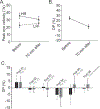Using Unidirectional Rotations to Improve Vestibular System Asymmetry in Patients with Vestibular Dysfunction
- PMID: 31524871
- PMCID: PMC8055379
- DOI: 10.3791/60053
Using Unidirectional Rotations to Improve Vestibular System Asymmetry in Patients with Vestibular Dysfunction
Abstract
The vestibular system provides information about head movement and mediates reflexes that contribute to balance control and gaze stabilization during daily activities. Vestibular sensors are located in the inner ear on both sides of the head and project to the vestibular nuclei in the brainstem. Vestibular dysfunction is often due to an asymmetry between input from the two sides. This results in asymmetrical neural inputs from the two ears, which can produce an illusion of rotation, manifested as vertigo. The vestibular system has an impressive capacity for compensation, which serves to rebalance how asymmetrical information from the sensory end organs on both sides is processed at the central level. To promote compensation, various rehabilitation programs are used in the clinic; however, they primarily use exercises that improve multisensory integration. Recently, visual-vestibular training has also been used to improve the vestibulo-ocular reflex (VOR) in animals with compensated unilateral lesions. Here, a new method is introduced for rebalancing the vestibular activity on both sides in human subjects. This method consists of five unidirectional rotations in the dark (peak velocity of 320°/s) toward the weaker side. The efficacy of this method was shown in a sequential, double-blinded clinical trial in 16 patients with VOR asymmetry (measured by the directional preponderance in response to sinusoidal rotations). In most cases, VOR asymmetry decreased after a single session, reached normal values within the first two sessions in one week, and the effects lasted up to 6 weeks. The rebalancing effect is due to both an increase in VOR response from the weaker side and a decrease in response from the stronger side. The findings suggest that unidirectional rotation can be used as a supervised rehabilitation method to reduce VOR asymmetry in patients with longstanding vestibular dysfunction.
Figures


Similar articles
-
Rebalancing the Vestibular System by Unidirectional Rotations in Patients With Chronic Vestibular Dysfunction.Front Neurol. 2019 Jan 22;9:1196. doi: 10.3389/fneur.2018.01196. eCollection 2018. Front Neurol. 2019. PMID: 30723455 Free PMC article.
-
Pilot study of a new rehabilitation tool: improved unilateral short-term adaptation of the human angular vestibulo-ocular reflex.Otol Neurotol. 2014 Dec;35(10):e310-6. doi: 10.1097/MAO.0000000000000539. Otol Neurotol. 2014. PMID: 25122595
-
Unidirectional rotations produce asymmetric changes in horizontal VOR gain before and after unilateral labyrinthectomy in macaques.Exp Brain Res. 2011 May;210(3-4):651-60. doi: 10.1007/s00221-011-2622-2. Epub 2011 Mar 23. Exp Brain Res. 2011. PMID: 21431432 Free PMC article.
-
Acute unilateral loss of vestibular function.Handb Clin Neurol. 2016;137:219-29. doi: 10.1016/B978-0-444-63437-5.00015-7. Handb Clin Neurol. 2016. PMID: 27638073 Review.
-
New advances regarding adaptation of the vestibulo-ocular reflex.J Neurophysiol. 2019 Aug 1;122(2):644-658. doi: 10.1152/jn.00729.2018. Epub 2019 Jun 19. J Neurophysiol. 2019. PMID: 31215309 Review.
Cited by
-
Vestibulo-Ocular Reflex Short-Term Adaptation Is Halved After Compensation for Unilateral Labyrinthectomy.J Assoc Res Otolaryngol. 2022 Jun;23(3):457-466. doi: 10.1007/s10162-022-00844-4. Epub 2022 Mar 21. J Assoc Res Otolaryngol. 2022. PMID: 35313363 Free PMC article.
References
-
- Huterer M, Cullen KE Vestibuloocular reflex dynamics during high-frequency and high-acceleration rotations of the head on body in rhesus monkey. Journal of Neurophysiology. 88 (1), 13–28 (2002). - PubMed
-
- Beraneck M et al. Long-term plasticity of ipsilesional medial vestibular nucleus neurons after unilateral labyrinthectomy. Journal of Neurophysiology. 90 (1), 184–203 (2003). - PubMed
-
- Beraneck M et al. Unilateral labyrinthectomy modifies the membrane properties of contralesional vestibular neurons. Journal of Neurophysiology. 92 (3), 1668–1684 (2004). - PubMed
Publication types
MeSH terms
Grants and funding
LinkOut - more resources
Full Text Sources
